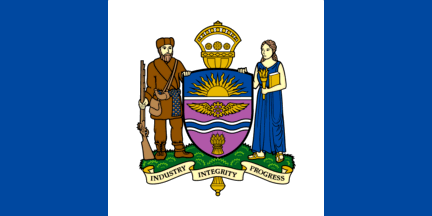 1:2
image by Arnaud Leroy, 14 November 2005
1:2
image by Arnaud Leroy, 14 November 2005Source: Edmonton city hall

Last modified: 2025-08-02 by rob raeside
Keywords: edmonton | alberta | mace | sun | winged wheel | sheaf | airport | edmonton airport | runway | athena | explorer | roses | indy | northlands |
Links: FOTW homepage |
search |
disclaimer and copyright |
write us |
mirrors
 1:2
image by Arnaud Leroy, 14 November 2005
1:2
image by Arnaud Leroy, 14 November 2005
Source: Edmonton city hall
See also:
Edmonton is the capital city of Alberta, situated on the North Saskatchewan River and the centre of the Edmonton Metropolitan Region, which is surrounded by Alberta's central region.
Text and image(s) from Canadian City Flags, Raven 18 (2011), courtesy of the North American Vexillological Association, which retains copyright. Image(s) by permission of Eugene Ipavec.
The flag of the City of Edmonton is a Canadian pale design of
blue-white-blue with a coat of arms in the centre, nearly the full height of the
flag. The shield is simple, with a curved top, rounded base, and black outline.
A white horizontal stripe divides it into two panels, the upper one-third
and the lower two-thirds. The upper panel is blue with a half-circle rising sun
depicted with 15 rays, alternating wavy and straight, all in yellow outlined in
black. The lower panel is light purple, crossed horizontally in its centre by a
wavy blue stripe bordered in white. Above the stripe is a double-winged wheel
and below is a sheaf of grain, both in yellow with black details. Behind the
shield, extending above and below it, is a mace, containing two stylized wild
roses flanking a larger marigold, all in yellow with black details. To the left
stands an explorer in brown leather with a bag and powder horn, holding a
rifle, in light brown. He wears a Métis sash of blue and brown checks. To
the right stands Athena in a blue gown holding a torch and a book, in yellow.
They stand on a mound of green. Below the shield is a ribbon in yellow in
three sections, inscribed INDUSTRY INTEGRITY PROGRESS in black serif letters. A ribbon in yellow reading EDMONTON in black serif letters
arches above the arms.
Alison Wilkes, Canadian City Flags,
Raven 18,
2011
The flag was originally designed in 1966 by Norman Yates,
Associate Professor of Art and Design at the University of Alberta, as a gift
for the upcoming centennial celebration in 1967. It was adopted by the city
council and shown at Expo ’67.
Alison Wilkes, Canadian City Flags,
Raven 18,
2011
Source: City of Edmonton, Policy Number A1432, Policy Title City Hall Space Use, dated 30 November 2000, effective date 09 April 2001, under the authority of the City Manager12. COMMUNITY FLAG/BANNER RAISINGS
12.01 Flags are permitted to be flown for up to one month, but this may be reduced if a scheduling conflict arises with another booking within that same period.
12.02 Groups organizing community banner raising events shall use the community flagpole located on the southwest corner of the plaza near the Cenotaph.
12.03 Groups shall manage the event themselves, and arrange access and operational details with the Communications Branch in advance.
12.04 Groups wishing to leave materials such as wreaths on-site shall inform the Booking Clerk prior to doing so.
12.05 City of Edmonton staff shall not be available for on-site support.
12.06 City of Edmonton shall not be held liable for any materials left on-site.
And that the city also specifies that for processions [in The Edmonton Traffic Bylaw, Part 9, Rules for Parades and Processions, Section 901 (Permit Necessary)[ that
(f)The approximate size, number and nature of flags, banners, placards or such similar things to be carried therein and particulars of signs, inscriptions and wording to be exhibited thereon; and such written application shall bear the signatures and addresses of the persons who will be in control of such parade or procession and who undertake to be responsible for the good order and conduct thereof.
Moreover, the city council's flag is only one of a number of "corporate trademarks". It also has a "City Signature" (logotype), Crest, Flower and Hat.
Source: City of Edmonton, City Policy C240, adopted 20 August
1991 (dates back to 1977).
Colin Dobson, 21 November 2005
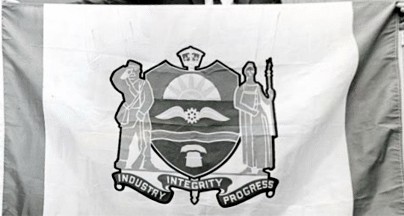 image located by Valentin Poposki, 14 December 2012
image located by Valentin Poposki, 14 December 2012
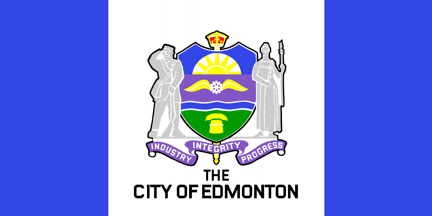 1:2 image by
Eugene Ipavec
1:2 image by
Eugene Ipavec
Source: Canadian City Flags,
Raven 18
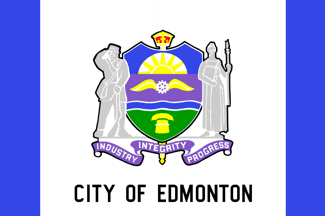 2:3 image by
Eugene Ipavec
2:3 image by
Eugene Ipavec
Source: Canadian City Flags,
Raven 18
Former flag/s of the City of Edmonton, Alberta [13.12.1966]
Source:
http://www.facebook.com
Dec. 13, 1966: City council endorses two
versions of Edmonton’s official flag "Without a dissenting vote, city council
approved two versions of the city’s official flag.
The versions were
identical except that one had the words “City of Edmonton” printed beneath the
crest, and would be used when the flag was flown outside the city. The other
would be used within the city.
Mayor Vincent Dantzer had Norman Yates,
associate professor of fine arts at the University of Alberta, incorporate the
city’s crest into the design, which featured a simple white background bordered
by two vertical blue bars. The white symbolized peace while the blue bars
alluded to the river, as the city’s most dominant feature.
The flag would
be hung in the council chambers, at flagpoles and from the mast at Pioneerland-Fort
Edmonton, the city’s venture at Expo 67 in Montreal. The city flag was updated
in 1986."
As you can [read] the flag is similar to the current, but with
much wider white field and with different interpretation of the coat of arms.
Also, the former flag had two version - with lettering "City of Edmonton" for
outdoor less official use, and without lettering for indoor more official use.
Vanja Poposki, 14 December 2012
At least four former versions of the flag have existed,
some with outer bars narrower than on a Canadian pale design. Originally
the City of Edmonton approved two versions, identical except for one with
CITY OF EDMONTON in black sans-serif letters below the arms (later the
was added above the other words), for use outside Edmonton. Slight changes
were made to the design over the years and the flag was officially updated in
1986 and after the formal grant of arms in 1995. The flag now includes a scroll
bearing the city’s name above the coat of arms, along with changes to Athena.
These changes have been a source of contention for the original flag designer.
When preparing to donate a signed copy
of the flag for a local fundraiser in 1986,
Professor Yates went to City Hall to get
one, and found that it significantly different
than his 1966 original. The city
had no official records to indicate how
or why the design had changed but suggested
the original design was forgotten
over time and that when the flag was
ordered again in the 1970s, it took on a
design including the original arms. In
a hearing in 1987 to determine the flag’s
fate, the city decided on a more updated
version of the city arms suggested by the
city’s visual identity committee. After the hearing, a disappointed Yates commented
that the new Athena resembled a “modern-day Bo-Peep”. He added
that the new flag was a bad decision and placing the name of the city on the
flag seemed provincial; he felt his original flag was truer to good flag design.
Alison Wilkes, Canadian City Flags,
Raven 18,
2011
Flag
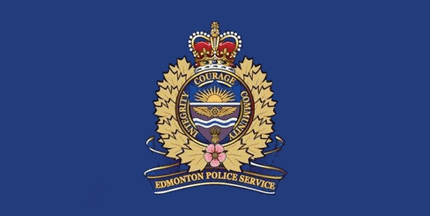 image by Valentin Poposki, 10 December 2021
image by Valentin Poposki, 10 December 2021
Crest Detail
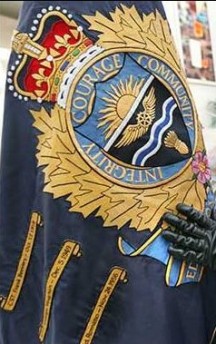 image contributed by Darrell Neuman, 14 March 2009
image contributed by Darrell Neuman, 14 March 2009
On Thursday, January 22, 2009, at an official ceremony held at City Hall the new flag and crest symbolizing the City of Edmonton Police Service was unveiled to the general public for the first time. This ceremony marks the culmination of nearly a decade of the Department’s efforts to get a flag and crest officially reviewed and sanctioned by Queen Elizabeth. This formal approval was necessary because of the depiction of the Royal Crown as part of the overall design.
On this flag there are the names of seven fallen officers: Const. Frank Beevers (1918), Const. William Nixon (1919), Const. George Vaughan (1949), Const. George Donnelly (1955), Const. Dave Romano (1956), Sgt. Malcolm Jack (1959) and Const. Ezio Faraone (1990).
The new police flag is similar in design to the municipal flag with
the removal of the supporters which flank the crest – an explorer in a
fur hat holding a rifle and Athena, the Goddess of Wisdom. A rising
sun represents long hours of sunshine during the summer, wings for
Edmonton’s aviation history and a wavy blue line representing the
North Saskatchewan River. Wild roses on the flag represent the
official flower of Alberta.
Darrell Neuman, 14 March 2009
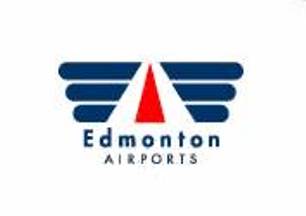 image contributed by Darrell Neuman, 24 April 2006
image contributed by Darrell Neuman, 24 April 2006
The Flag of Edmonton Airports which runs the Edmonton International
and City Center Airports.
Darrell Neuman, 24 April 2006
The airport authority logo, three blue rounded bars in decreasing size from the top over the airport name, divided by an incomplete white triangle, itself divided by a red triangle to five the appearance of: stylized wings surmounted by a runway.
About Edmonton Airports:
From http://www.edmontonairports.com/docs/yeg_econ.pdf
In August 1992, Edmonton International Airport (YEG) was devolved from the federally run Transport Canada airport network to be locally owned by Edmonton Airports, a not-for-profit, provincially incorporated company. YEG has emerged from this management transition as a community-operated airport granted the opportunity to establish commercial viability and independence by directly serving the needs of its customer base.
Edmonton Airports owns and operates a network of airports, including Edmonton International Airport, City Centre Airport, Cooking Lake Airport and Villenueve Airport. These airports serve the greater Edmonton area, Central Alberta, Northern Alberta, and northern regions of BC.
EDMONTON INTERNATIONAL AIRPORT (YEG)
Edmonton International Airport was 5th ranked passenger airport in Canada in 2001. Since its transfer from Transport Canada in 1992, the passenger traffic at YEG has grown 9% on average per annum, making it one of the fastest growing major airports in Canada. Site statistics report a total of 3.9 million enplaned and deplaned passengers in 2001.
From: In 1995, Edmontonians voted overwhelmingly (77%) in a referendum to
consolidate scheduled passenger air services at Edmonton
International Airport. Subsequently, Edmonton City Centre Airport
became a dedicated corporate and general aviation facility. Merging
passenger operations at Edmonton International Airport (YEG)
increases the potential to provide expanded and improved air service
to the Capital Region. Two leading aviation consultants, InterVISTAS
Consulting Inc. and Sypher Mueller International, were engaged to
objectively measure and evaluate the success of Edmonton Airports in
achieving the stated benefits of consolidation as forecasted in
1995. This report represents a summary of their findings and an
evaluation of the following air service changes over the past decade:
Other airports managed by the Authority:
Villeneuve Airport
(http://www.edmontonairports.com/bins/content_page.asp?cid=15-54)
The primary flight training facility of the Edmonton Capital Region,
the Villeneuve Airport features two paved runways (3500 feet x 100
feet). The Villeneuve Tower operates daily from 0800 - 2200 hours.
A small public terminal facility is located next to the tower.
The airport is also home to a number of commercial enterprises
including aircraft flight training and aircraft maintenance.
Villeneuve is often the site of air cadet glider training
Edmonton City Centre Airport
(http://www.edmontonairports.com/bins/content_page.asp?cid=15-53)
ECCA is home to small charters, private and corporate aircraft,
training, military, industrial and medevac flights. ECCA has
everything the general aviation enthusiast needs from fixed base
operators to aircraft painting and maintenance to all the advantages
of being located within the City.
Cooking Lake Airport
(http://www.edmontonairports.com/bins/content_page.asp?cid=15-55)
Services at Cooking Lake Airport include a flight training school,
charter services, aircraft maintenance and repair establishments.
100LL fuel is also available. Used primarily for privately owned
float planes and small wheeled aircraft, the facility is equipped
for VFR day/night with a rotating beacon, Visual Approach Slope
Indicator System (VASIS), Aircraft Radio Control of Aerodrome
Lighting (ARCAL), and an Automated Weather Observation Station
(AWOS).
One of the most unique features of this facility is that it is
Canada's only "bare land condominium airport". The owners of the
hangar lots comprise the condominium association. Future lots will
be developed.
Phil Nelson, 30 April 2006 This is the flag of the Edmonton Indy Car Race which takes place the last
weekend in July. This event occurs at the City Center Airport which City Council
has decided will be closed over a number of years with portions of the land
being sold off for commercial and residential development. NAIT is also looking
to expanding its campus on land currently being used by the airport. The car
race has not been profitable and may be discontinued after the final year of a
five year agreement has expired. The Edmonton Klondike Days flag features “Klondike Mike” the traditional
mascot of this summer festival which was held each year in July. The
representation of Klondike Mike on the flag over the years had undergone
significant design changes. The design of this particular flag I believe dates
back to the early 1970s.
This is the flag of Northlands which operates the annual summer festival
called CapitalEx in Edmonton. More details at
http://en.wikipedia.org/wiki/Northlands.
The image is the flag of Vimy Ridge Academy operated by Edmonton Public
Schools in Edmonton, Alberta. This past weekend the Edmonton Journal newspaper had an article about
designing a new municipal flag for the City of Edmonton. This is the link to
this article:
http://edmontonjournal.com/news/insight/maybe-the-magpie-defines-us-creativity-meets-symbolism-as-support-grows-to-redesign-the-city-flag
Flag is the corporate logo on white.
The flag of the Canadian Native Friendship Centre Edmonton is white with the
Centre logo on it. The flag can be seen on a short video here:
https://www.instagram.com/p/CymOWTeP7OB/
Edmonton Indy
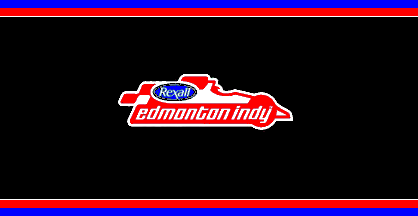 image contributed by Darrell Neuman, 27 July 2009
image contributed by Darrell Neuman, 27 July 2009
Darrell Neuman, 27 July 2009
Edmonton Klondike Days Flag (1970s)
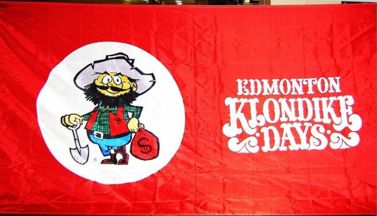 image contributed by Darrell Neuman, 23 July 2010
image contributed by Darrell Neuman, 23 July 2010
The marketing of Klondike Days and the Klondike
theme has been discontinued and replaced by a summer festival called CapitalEx.
Darrell Neuman, 23 July 2010
Northlands
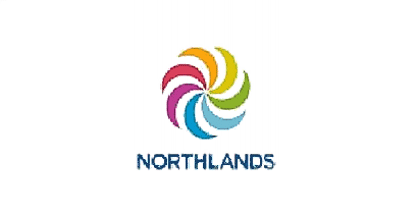 image contributed by Darrell Neuman, 4 August 2011
image contributed by Darrell Neuman, 4 August 2011
Darrell Neuman, 4 August
2011
Vimy Ridge Academy
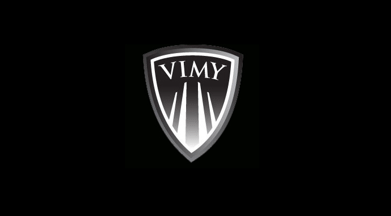 image located by Darrell Neuman, 25 November 2013
image located by Darrell Neuman, 25 November 2013
Darrell Neuman, 25 November 2013
Debate over new design of City of Edmonton Flag
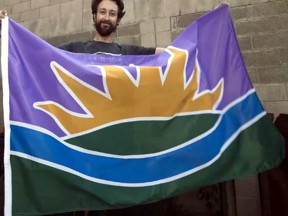 image contributed by Darrell Neuman, 26 September 2016
image contributed by Darrell Neuman, 26 September 2016
Another design suggestion features a bird: the magpie.
The
debate over the design of a new city flag has just started and no real progress
is likely to happen until after the municipal elections in 2017.
Darrell
Neuman, 26 September 2016
Edmonton International Airport
![[Edmonton International Airport Flag]](../images/c/ca-ab-ed$air.gif) image by Dave Fowler, 20 December 2021
image by Dave Fowler, 20 December 2021
Dave Fowler, 20 December
2021
Canadian Native Friendship Centre Edmonton
![[Flag]](../images/c/ca-ab-cnfce.gif) image located by Valentin Poposki, 29 July 2025
image located by Valentin Poposki, 29 July 2025
Valentin Poposki, 29
July 2025